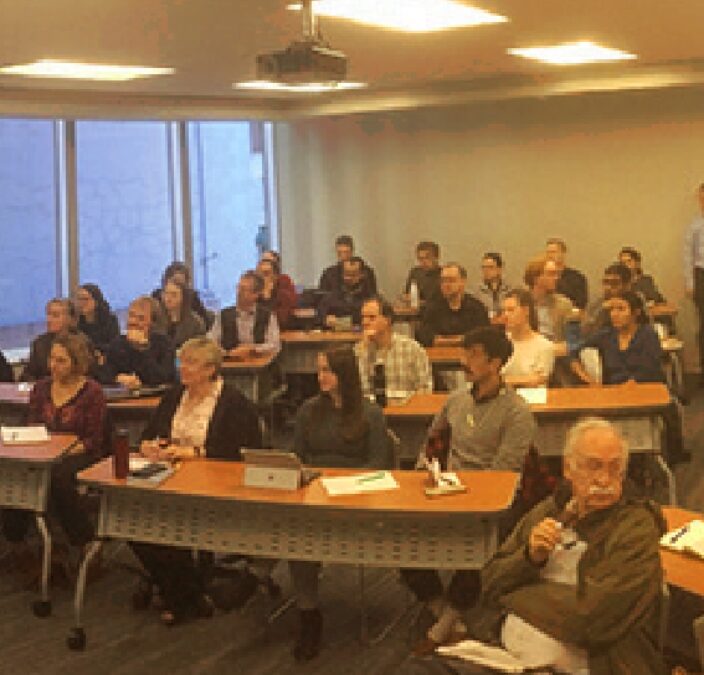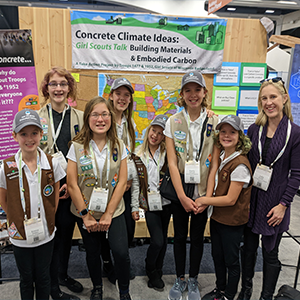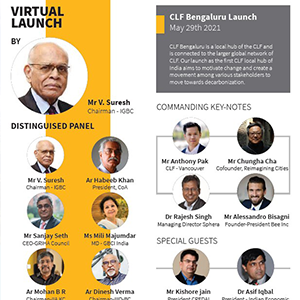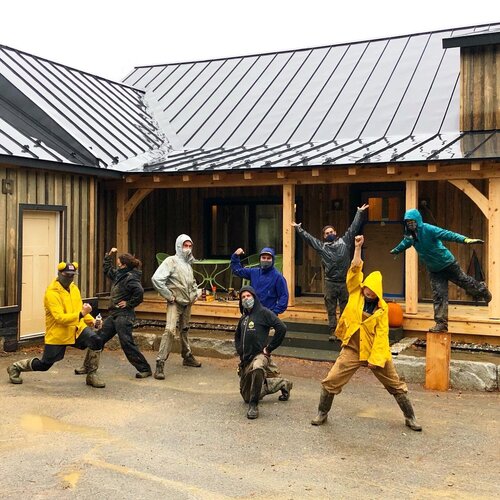«Tous les ingénieurs en structure doivent comprendre, réduire et finalement éliminer le carbone incorporé dans leurs projets d'ici 2050.»
Conceived of and developed by members of the Carbon Leadership Forum — including Duncan Cox (Thornton Tomasetti), Catherine De Wolf (MIT/EPFL), Amy Hattan (Thornton Tomasetti), Erin McDade (Architecture 2030), Kate Simonen (Carbon Leadership Forum/UW), Wil Srubar (U Colorado Boulder), and Frances Yang (Arup) — the SE 2050 Challenge was designed to ignite structural engineers and their firms to meet embodied carbon benchmarks and ambitious reduction goals, and be recognized for the significant role they can play towards these targets.

Un siège au premier rang pour le développement du défi
par Frances Yang
Associate and Sustainability Consultant chez Arup à San Francisco
The journey of the SE 2050 Initiative began four years ago, catalyzed by several streams of activity heading in the same direction. The seven individuals who started the initiative had two primary motivations: we wanted to inspire and engage structural engineers to drive down embodied carbon in their designs, and to contribute data to establish benchmarks and targets. The Carbon Leadership Forum had just completed a étude comparative complète qui a identifié la nécessité de collecter davantage de données de manière beaucoup plus systématique et organisée afin de fixer des objectifs carbone incorporés pour Architecture 2030.
Arup was invited to join due to multiple touch points. Our own history included an internal effort starting in 2009 to obtain embodied carbon benchmarks by compiling data from over 80 projects from publicly available case studies plus our own. This also formed the start of an internal project tracking effort. When the CLF needed data for Architecture 2030 targets we were able to offer more than 400 data points for the bench-marking study. In parallel, Arup had also helped to create the UK WRAP (now RICS) Embodied Carbon Database, and assisted the development of the MIT material quantities database. These activities reflect Arup’s decades-long commitment to sustainability and the firm’s belief that addressing total carbon in the built environment is essential to its mission to “shape a better world.”
While the seven of us were advancing our organizations in our own ways, we realized that by coming together we could jump start a program to reach the entire structural engineering community. Inspired by the Engagement AIA 2030, we saw that a program to motivate, equip, and keep firms accountable — while also providing useful data to scientific and policy communities — would be essential for any hopes of reaching net zero embodied carbon by 2050. The CLF provided the incubation space for us to initiate SE 2050.
Sous les auspices de la CLF, nous avons publié le Défi SE 2050. Nous avons pu tirer parti du réseau CLF pour recueillir 140 signatures d'ingénieurs en structure et de supporters en seulement 4 semaines, en demandant au Institut de génie des structures (SEI) to commit to “understand, reduce and ultimately eliminate embodied carbon in their projects by 2050.” We reached out directly to the SEI Sustainability Committee, and were elated to see the committee quickly form the SE 2050 Working Group. In short order, the Working Group secured an all-day meeting with members of SEI’s Board of Governors, created an astounding website, and officially launched the beta-phase of the SE 2050 Commitment Program. The CLF was also critical at the face-to-face meeting with SEI leadership. Alongside its longtime partners from the AIA, Architecture 2030, and USGBC, the CLF brought both urgency and invitation never before directed to our national structural engineering organization on matters of our climate crisis. SEI endorsed the SE 2050 Challenge a few months later.
As someone who was in the SE 2050 incubation group, and is now on the SEI SE 2050 committee, I am excited about the commitment and prospects of SE 2050, and how it will accelerate efforts of the seven founding members towards those two original goals. We are still at the start of the road, as there is a lot of work to do. So join us! While SEI’s committee now leads the way, there is plenty of room for all on this straighter and broader path that the CLF has paved.

Frances Yang, associée et consultante en développement durable chez Arup à San Francisco
Les ingénieurs en structure relèvent le défi
par Michael Gryniuk
Associate and Project Manager chez LeMessurier à Boston
When the Carbon Leadership Forum (CLF) approached the Sustainability Committee of the American Society of Civil Engineers (ASCE) Structural Engineering Institute (SEI) in late 2017 with the concept of SE 2050 I had been on the committee for mere months but was immediately hooked. I was fascinated with the possibility of designing structural systems in a way that would result in net-zero embodied carbon emissions! The timing was also perfect.
J'avais commencé à me demander quel était l'impact de ma carrière sur l'environnement. Passant une grande partie de mon temps libre dans les bois à faire du vélo ou de la randonnée, j'ai développé une appréciation pour la nature et l'importance cruciale de la protéger. Équipé d'une compréhension de la science derrière le réchauffement climatique et de la nécessité urgente de plafonner nos émissions de gaz à effet de serre encore accentuée par l'Accord de Paris sur le climat, j'essaie de trouver des moyens de limiter les gaz à effet de serre à un niveau personnel. Mais en faisais-je assez dans tous les aspects de ma vie? Quel a été l'impact réel des bâtiments que j'ai conçus? Le monde est terriblement grand, après tout.
About 4 months earlier I was 3 years into a 5-year process of managing the design and construction administration of a large mixed-use development project in Boston that was entering the early stages of construction. The large excavation was complete, subgrade prepped, bars tied, and forms set for a 3,500 cubic yard mat concrete placement. My inner nerd was rather excited. A few days later I found myself doing some basic calculations (probably instead of reviewing the steel shop’s drawings as I was supposed to) on the mat’s embodied carbon. “This can’t be right” I remember thinking. “Really?”. It was. I would have to drive my car from Boston to the White Mountains of New Hampshire and back again over 8,000 times to match the equivalent carbon dioxide. I got to work.
Depuis l'introduction de SE 2050 jusqu'à maintenant, je me suis concentré presque exclusivement sur la réalisation d'un programme d'engagement SE 2050 officiellement sanctionné par SEI. Et j'ai eu le plaisir absolu de le faire avec un groupe de bénévoles extrêmement talentueux et dévoués. Se faire des amis et aider l'environnement. Deux pour deux! Notre groupe a travaillé sans relâche au cours des deux dernières années, naviguant les différents succès et défis avec détermination et intelligence. Le 19 décembre 2019, le conseil des gouverneurs de SEI a voté pour approuver le défi SE 2050 de la CLF et le 8 avril 2020, il a voté pour établir officiellement le programme d'engagement SE 2050 et notre comité SE 2050 pour lesquels je suis honoré de servir en tant Chaise. Nous prévoyons de lancer le programme en novembre à Greenbuild.
My engagement with the SEI Sustainability Committee and involvement with SE 2050 and the CLF has translated directly to my career as a structural engineer at LeMessurier where I now direct our firm’s sustainability group developing new and unique sustainability best practices. We now have a dedicated staff able to provide project support to the firm on all items related to sustainability, and I’m proud to say LeMessurier has been a sponsor of the CLF since 2018. We were also one of the first firms to sign on to the CLF’s SE 2050 Challenge and were an early adopter and sponsor of the EC3 tool.
Ne vas-tu pas prendre le même engagement et nous aider à progresser ensemble?
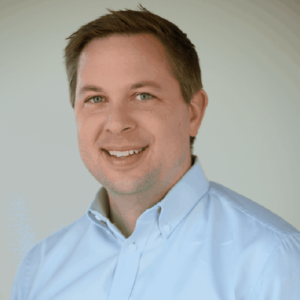
Michael Gryniuk, associé et chef de projet chez LeMessurier à Boston
